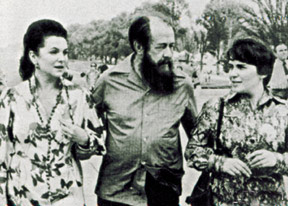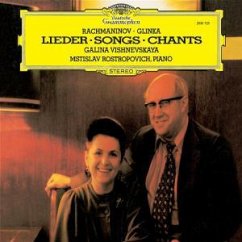
Hvad hører du nu ?
En fin uge starter med allerede planlagt Guldfinale. Solen står lige over kirketårnet - og Pogorelich spiller Bach.


mvh. SES.
To listen is an effort, and just to hear is no merit. A duck hears also. Igor Stravinsky
Vi har alle lært at skjule vore fordomme, og vi viser ikke vore forkerte meninger. PO Enquist 1976.
To listen is an effort, and just to hear is no merit. A duck hears also. Igor Stravinsky
Vi har alle lært at skjule vore fordomme, og vi viser ikke vore forkerte meninger. PO Enquist 1976.
-

SES. - Supermedlem
- Indlæg: 2578
- Tilmeldt: tirs okt 25, 2005 06:58
- Geografisk sted: Midtfyn
Den følger jeg lige op med:(endnu et 5kr fund)

Spændende pianist, som der skal støves mere op med. Tak SES

Spændende pianist, som der skal støves mere op med. Tak SES
-

fan of the man - Seniormedlem
- Indlæg: 931
- Tilmeldt: man jan 02, 2006 08:11
- Geografisk sted: Jylland
fan of the man skrev:Den følger jeg lige op med:(endnu et 5kr fund)
Spændende pianist, som der skal støves mere op med. Tak SES
Herligt - jeg har en stående ordre fra Wifi: Du køber alt hvad du ser med Pogorelich, endnu en af hendes pianister (min også).
Der er ikke så mange med ham. Håber du ser Ravel's Gaspard en dag, ret enestående.
En fin Chopin pianist, der gås uden om føleriet og lige på musikken.
mvh. SES.
To listen is an effort, and just to hear is no merit. A duck hears also. Igor Stravinsky
Vi har alle lært at skjule vore fordomme, og vi viser ikke vore forkerte meninger. PO Enquist 1976.
To listen is an effort, and just to hear is no merit. A duck hears also. Igor Stravinsky
Vi har alle lært at skjule vore fordomme, og vi viser ikke vore forkerte meninger. PO Enquist 1976.
-

SES. - Supermedlem
- Indlæg: 2578
- Tilmeldt: tirs okt 25, 2005 06:58
- Geografisk sted: Midtfyn
Galina Vishnevskayas bog om sit liv i Rusland som overlever under 2 verdenskrig og som overlever i total korrumperet samfund hvor intet er for lavt er must læsning for alle, også musikinteresserede.
Under læsningen er et passende udvalg plader med Moussorsky, Tshaikowsky, Rachmanoiov, Prokofieff og selvfølgelig vennerne Shostakovich og Britten nødvendigt. Min samling med hende er for lille, derimod er der ikke de helt store mangler med gemalen Mstilav Rostropovich,
Specielt Prokofieff har været på spillen de snere dage. Symfonier, klaverkoncerter og sonater.



mvh. SES.
To listen is an effort, and just to hear is no merit. A duck hears also. Igor Stravinsky
Vi har alle lært at skjule vore fordomme, og vi viser ikke vore forkerte meninger. PO Enquist 1976.
To listen is an effort, and just to hear is no merit. A duck hears also. Igor Stravinsky
Vi har alle lært at skjule vore fordomme, og vi viser ikke vore forkerte meninger. PO Enquist 1976.
-

SES. - Supermedlem
- Indlæg: 2578
- Tilmeldt: tirs okt 25, 2005 06:58
- Geografisk sted: Midtfyn
Nine Horses: Money for All (min første 07, udk. 22.01 , men der står 2006 på  )
)
Nine Horses er David Sylvian, Steve Jansen og Burnt Friedman.
Money for All er en gang "fej op" efter et album fra 2005; Snow Borne Sorrow, der røg helt forbi min radar. På denne er der 3 remixes/fortolkninger af numre fra SBS, 2 nye numre i hver 2 versioner og et "Japan only" bonusnr. Snow Borne Sorrow skulle være fantastisk, og i hvert fald er Money for All så rigeligt worth all the money.
Mvh
-

gurdet - Supermedlem
- Indlæg: 1581
- Tilmeldt: søn jan 22, 2006 14:22
- Geografisk sted: københavn
Mere Rus land.

En 1. klasses indspilning af de 2 koncerter, og superb lyd.

En 1. klasses indspilning af de 2 koncerter, og superb lyd.
mvh. SES.
To listen is an effort, and just to hear is no merit. A duck hears also. Igor Stravinsky
Vi har alle lært at skjule vore fordomme, og vi viser ikke vore forkerte meninger. PO Enquist 1976.
To listen is an effort, and just to hear is no merit. A duck hears also. Igor Stravinsky
Vi har alle lært at skjule vore fordomme, og vi viser ikke vore forkerte meninger. PO Enquist 1976.
-

SES. - Supermedlem
- Indlæg: 2578
- Tilmeldt: tirs okt 25, 2005 06:58
- Geografisk sted: Midtfyn
Korte udsagn: Det korteste jeg kender er Schubert, det er nok at sige ”Schubert”. Man kan så skrive en hel bog for at forklare sig, men det nemmeste er at lære ham at kende – så dækker ordet Schubert Schubert.
De andre skal have lidt flere ord med.


De andre skal have lidt flere ord med.


mvh. SES.
To listen is an effort, and just to hear is no merit. A duck hears also. Igor Stravinsky
Vi har alle lært at skjule vore fordomme, og vi viser ikke vore forkerte meninger. PO Enquist 1976.
To listen is an effort, and just to hear is no merit. A duck hears also. Igor Stravinsky
Vi har alle lært at skjule vore fordomme, og vi viser ikke vore forkerte meninger. PO Enquist 1976.
-

SES. - Supermedlem
- Indlæg: 2578
- Tilmeldt: tirs okt 25, 2005 06:58
- Geografisk sted: Midtfyn

Ungarsk Jazz? Med dybe rødder i Bach og Bartok? Fungerer det ? I mine ører det rene fløde tilsat paprika. Produktion til 13+
The basic idea for the recording, "Contrasts and Parallels" actually came from producer Todd Garfinkle. A few years ago, as we were in the planning stages and thinking of what to do for MA, Todd suggested that we record my own jazz trio version of Bach’s Goldberg Variations, but that we should finish the record with a couple of Hungarian folk song adaptations. At first I couldn’t relate to the idea, because I thought that these two musical worlds were very far from each other. Then however, I realized that there are at least as many "parallels" as "contrasts" to be found, if you’re really looking. It is enough just to mention Béla Bartók, in whose late compositions the stylistic elements of Hungarian and Oriental folk music are significantly complemented by a contrapuntal development that clearly refers to J. S. Bach.
Alright, but the question then was: "How can I make these genres connect with each other, if I am to convey both of them through the improvisational language of jazz?" Clearly, there is an absolute need for a general idea that will recognizably join — even for the uninitiated - the different musical worlds involved. I didn’t have to ponder for too long before I hit on the obvious key concept: "VARIATION". This offered a natural connection to jazz, as the classical music form that stands closest to this genre is none other than the variation form. From this point the solution came rather naturally: I divided the content of the record into two parts, where the first part consisted of "Variations on Bach’s Goldberg Variations", in which besides the original, but reinterpreted Bach themes, my own "variations" or improvisations can also be heard, unfolding from certain motifs and harmonies in Bach`s music. The second part consists of my own composition based on a Hungarian folk song but developed through the forms of classical music, and of course, the improvisational parts are not missing either. That is how the piece called "Variations on a Folk Song" was conceived. I feel that in this work, I succeeded in creating a synthesis of three different musical styles (jazz- Baroque-folk music), whereas the first part consist of only two. The synthesis is most successful in the movement entitled "Passacaglia", since Passacaglia is one of the variational forms used in Baroque music, and here the Passacaglia theme is created from the basic motif of the folk song that is constantly present behind the Baroque and jazz style variations.
Obviously, this kind of production needed partners who are extremely open to all three musical worlds, and we found them in János Egri and Ferenc Németh.
After the two suites, we end the record with a short musical "afterthought", in which a folk song singer with an extraordinary and original voice, Irén Lovász sings. This "Afterthought" was written in homage to Béla Bartók, who also adapted this beautiful, simple folk song in his masterpiece entitled "Mikrokosmos." Bartók’s music has always had a very special place in my heart, his style greatly influencing my work both as a jazz pianist and a composer. For me, next to Bach, Bartók is the greatest composer. In both their musics, contrasting concepts such as "liberty — constraint" "consciousness - intuition" or "complexity - simplicity" have an equally significant role.
Kálmán Oláh
mvh. SES.
To listen is an effort, and just to hear is no merit. A duck hears also. Igor Stravinsky
Vi har alle lært at skjule vore fordomme, og vi viser ikke vore forkerte meninger. PO Enquist 1976.
To listen is an effort, and just to hear is no merit. A duck hears also. Igor Stravinsky
Vi har alle lært at skjule vore fordomme, og vi viser ikke vore forkerte meninger. PO Enquist 1976.
-

SES. - Supermedlem
- Indlæg: 2578
- Tilmeldt: tirs okt 25, 2005 06:58
- Geografisk sted: Midtfyn

Beethoven violinkoncert kan jeg altid høre. Her er en af de rigtig gode - på et billigt mærke. Endvidere er cd'en lidt skæv så der kommer lidt støj fra spillen, hyggeligt næsten analogt
mvh. SES.
To listen is an effort, and just to hear is no merit. A duck hears also. Igor Stravinsky
Vi har alle lært at skjule vore fordomme, og vi viser ikke vore forkerte meninger. PO Enquist 1976.
To listen is an effort, and just to hear is no merit. A duck hears also. Igor Stravinsky
Vi har alle lært at skjule vore fordomme, og vi viser ikke vore forkerte meninger. PO Enquist 1976.
-

SES. - Supermedlem
- Indlæg: 2578
- Tilmeldt: tirs okt 25, 2005 06:58
- Geografisk sted: Midtfyn
-

fan of the man - Seniormedlem
- Indlæg: 931
- Tilmeldt: man jan 02, 2006 08:11
- Geografisk sted: Jylland
Hvem er online
Brugere der læser dette forum: Ingen tilmeldte og 3 gæster









